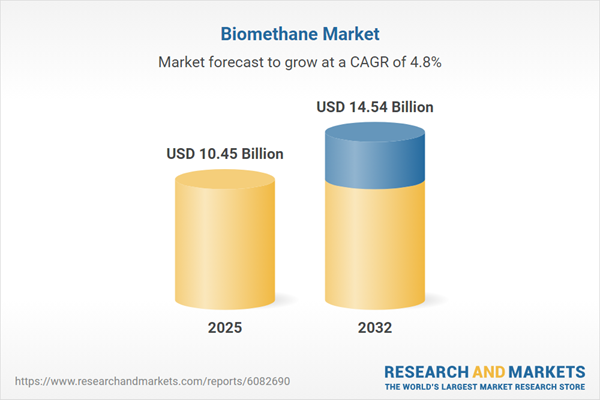Speak directly to the analyst to clarify any post sales queries you may have.
The biomethane market is quickly becoming a strategic focus for organizations seeking to lower emissions and secure sustainable energy supply in the global transition toward renewables. As market dynamics accelerate, decision-makers need actionable intelligence to remain ahead in this evolving sector.
Market Snapshot: Biomethane Market Size and Trajectory
The Biomethane Market grew from USD 9.99 billion in 2024 to USD 10.45 billion in 2025. It is expected to continue growing at a CAGR of 4.80%, reaching USD 14.54 billion by 2032. With robust policy support and increasing private investment, stakeholders are leveraging the carbon neutrality potential of biomethane to address energy transition goals. Compatibility with existing gas infrastructure is facilitating broader adoption across sectors, while a diversified feedstock base enhances resilience against market and supply disruptions. The sector continues to evolve rapidly, shaped by technological progress, regulatory momentum, and emerging regional opportunities.
Scope & Segmentation of the Biomethane Market
This comprehensive report delves into the global biomethane market across a range of critical dimensions, highlighting market structure and key player strategies:
- Feedstock: Agricultural Waste, Animal Manure, Energy Crops, Industrial Food Processing Waste, Organic Household Waste, Sewage Sludge
- Production Process: Anaerobic Digestion, Gasification, Pyrolysis
- Application: Alternative Fuel, Combine Heat & Power, Electricity Generation, Heat Generation
- End-Use: Commercial, Industrial, Residential
- Region: Americas (including United States, Canada, Mexico, Brazil, Argentina, Chile, Colombia, Peru), Europe, Middle East & Africa (including United Kingdom, Germany, France, Russia, Italy, Spain, Netherlands, Sweden, Poland, Switzerland, United Arab Emirates, Saudi Arabia, Qatar, Turkey, Israel, South Africa, Nigeria, Egypt, Kenya), and Asia-Pacific (including China, India, Japan, Australia, South Korea, Indonesia, Thailand, Malaysia, Singapore, Taiwan)
- Key Companies: 2G Energy AG, AB Holdings SpA, Air Liquide S.A., Biogas Products Ltd., Biokraft International AB by St1 Nordic, BTS Biogas Srl/GmbHby Bioenergy DevCo LLC, Chevron Corporation, ENGIE Group, Eni S.p.A., EnviTec Biogas AG, ETW Energietechnik GmbH, Future Biogas Limited, Gasum Oy, Greenlane Renewables, Kanadevia Inova Schmack GmbH by Hitachi Zosen Inova AG, Orbital Gas Systems by nZero Group, Pentair PLC, PlanET Biogastechnik GmbH, Prodeval SAS, Repsol, S.A., Shell plc, Suomen Biovoima Oy, Synthica Energy, LLC, TOTALENERGIES GAS MOBILITY B.V., VERBIO AG, Vitol Biomethane LLC, Waga Energy SA, WELTEC BIOPOWER GMBH
Key Takeaways for Senior Decision-Makers
- Biomethane is solidifying its position as a foundational resource in the global energy transition, addressing both emission reduction and waste valorization objectives.
- Regulatory frameworks, such as carbon pricing and renewable gas certification, are accelerating project pipelines and strengthening market confidence across regions.
- Feedstock diversification, including municipal, industrial, and agricultural sources, offers supply assurance and greater flexibility against commodity volatility.
- Advancements in process engineering and digital plant management are reducing operational costs and optimizing resource use, increasing economic viability.
- Strategic collaborations—spanning from technology partnerships to cross-sector alliances—are unlocking new business models and reinforcing value chain integration.
- Rapid regional growth is seen in markets aligning policy incentives with infrastructure improvements, helping to shape competitive advantage and open new investment channels.
Tariff Impact: US Measures for 2025
Planned US tariff measures on imported biomethane equipment could impact supply chain costs and shift investment decisions. Many developers are now evaluating local sourcing and manufacturing strategies to maintain competitiveness. These policy changes may encourage industrial expansion and deeper collaboration with domestic suppliers, influencing long-term market structure. Navigating this landscape will require creative financing solutions and adaptive sourcing models.
Methodology & Data Sources
The analysis is built on a mixed-method approach, combining primary interviews with industry leaders and stakeholders along the value chain, as well as secondary research sourced from regulatory filings, technical publications, and industry associations. All findings are validated through statistical analysis and triangulated with expert opinions to ensure accuracy and reliability.
Why This Report Matters for Biomethane Stakeholders
- Enables senior leaders to benchmark against evolving policy, technology, and competitive trends, positioning organizations for sustainable growth and investment opportunities.
- Supports tactical decisions on feedstock sourcing, technology adoption, and market entry by providing comprehensive sectoral and regional insights.
- Equips teams to proactively respond to regulatory shifts and capitalize on the accelerating momentum toward net-zero energy systems.
Conclusion
The biomethane market is advancing as a key enabler of decarbonization strategies worldwide. Stakeholders who harness these insights can drive effective decision-making and secure competitive advantage in this dynamic sector.
Table of Contents
3. Executive Summary
4. Market Overview
7. Cumulative Impact of Artificial Intelligence 2025
Companies Mentioned
The companies profiled in this Biomethane market report include:- 2G Energy AG
- AB Holdings SpA
- Air Liquide S.A.
- Biogas Products Ltd.
- Biokraft International AB by St1 Nordic
- BTS Biogas Srl/GmbHby Bioenergy DevCo LLC
- Chevron Corporation
- ENGIE Group
- Eni S.p.A.
- EnviTec Biogas AG
- ETW Energietechnik GmbH
- Future Biogas Limited
- Gasum Oy
- Greenlane Renewables
- Kanadevia Inova Schmack GmbH by Hitachi Zosen Inova AG
- Orbital Gas Systems by nZero Group
- Pentair PLC
- PlanET Biogastechnik GmbH
- Prodeval SAS
- Repsol, S.A.
- Shell plc
- Suomen Biovoima Oy
- Synthica Energy, LLC
- TOTALENERGIES GAS MOBILITY B.V.
- VERBIO AG
- Vitol Biomethane LLC
- Waga Energy SA
- WELTEC BIOPOWER GMBH
Table Information
| Report Attribute | Details |
|---|---|
| No. of Pages | 187 |
| Published | November 2025 |
| Forecast Period | 2025 - 2032 |
| Estimated Market Value ( USD | $ 10.45 Billion |
| Forecasted Market Value ( USD | $ 14.54 Billion |
| Compound Annual Growth Rate | 4.8% |
| Regions Covered | Global |
| No. of Companies Mentioned | 29 |









